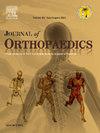Total ankle arthroplasty versus ankle arthrodesis in end-stage osteoarthritis: A meta-analysis of comparative outcomes
IF 1.5
Q3 ORTHOPEDICS
引用次数: 0
Abstract
The treatments for end-stage ankle arthritis are challenging. Standard treatment methods include ankle arthrodesis (AA) and total ankle arthroplasty (TAA). This meta-analysis compares the outcomes of TAA and AA based on comparative studies. Literature databases include PubMed, Embase, and Google Scholar. Keywords related to the treatment of end-stage ankle osteoarthritis with AA compared to TAA were used. The outcome measurements include functional outcomes and revision rates. Review Manager 5.4 was used to conduct statistical analysis. A standard p-value of <0.05 indicated statistical significance. 27 comparison articles, including data from 12,341 patients, were included in the meta-analysis. 4917 patients underwent total ankle arthroplasty, while 7440 underwent ankle arthrodesis. The results showed a significant difference in the AOFAS score favoring TAA (p < 0.001). Dorsiflexion range of motion (ROM) also showed a significant difference in favor of TAA (p < 0.001). Additionally, the TAA group's plantarflexion ROM was significantly superior (p < 0.001). The overall SF-36 score, which measures quality of life, reported improved outcomes for patients who underwent TAA compared to those with AA (p < 0.001). The Activities of Daily Living, calculated by the Foot and Ankle Ability Measure (FAAM) score, also showed significant improvement in patients who had TAA compared to those who received AA (p < 0.001). When both the Activities of Daily Living and Sports subscales were combined, there was a significant improvement in the total FAAM score for TAA patients (p < 0.001). However, there was a significant difference in revision rates favoring AA (p < 0.001). This meta-analysis compared postoperative outcomes of ankle arthrodesis (AA) and total ankle arthroplasty (TAA) through patient-reported and functional measures. By synthesizing qualitative and quantitative data, we identified TAA as the superior intervention, demonstrating significant advantages in AOFAS scores, FAAM activities of daily living, FAAM total scores, SF-36 total scores, and range of motion. These findings aid in tailoring surgical decisions for end-stage ankle osteoarthritis, particularly when patient-specific factors such as anatomical suitability, comorbidities, or access to advanced care limit treatment options. Additionally, this study supports the recent trend of showing comparable revision rates between TAA and AA.
Level of evidence
3.
终末期骨关节炎的全踝关节置换术与踝关节融合术:比较结果的荟萃分析
终末期踝关节关节炎的治疗具有挑战性。标准的治疗方法包括踝关节置换术(AA)和全踝关节置换术(TAA)。本荟萃分析比较了TAA和AA在比较研究基础上的结果。文献数据库包括PubMed、Embase、b谷歌Scholar等。使用与AA与TAA治疗终末期踝关节骨性关节炎相关的关键词。结果测量包括功能结果和修正率。使用Review Manager 5.4进行统计分析。标准p值为<;0.05表示有统计学意义。meta分析纳入了27篇比较文章,包括来自12341名患者的数据。4917例患者行全踝关节置换术,7440例行踝关节融合术。结果显示TAA在AOFAS评分上有显著差异(p <; 0.001)。背屈活动范围(ROM)也显示了TAA的显著差异(p <; 0.001)。此外,TAA组的跖屈曲ROM明显优于对照组(p <; 0.001)。衡量生活质量的总体SF-36评分显示,与AA患者相比,TAA患者的预后有所改善(p <; 0.001)。通过足踝能力测量(FAAM)评分计算的日常生活活动也显示,与接受AA的患者相比,TAA患者的日常生活活动有显著改善(p <; 0.001)。当日常生活活动和运动亚量表合并使用时,TAA患者的FAAM总分有显著改善(p <; 0.001)。然而,支持AA的修正率有显著差异(p <; 0.001)。本荟萃分析通过患者报告和功能测量比较了踝关节融合术(AA)和全踝关节置换术(TAA)的术后结果。通过综合定性和定量数据,我们确定TAA在AOFAS评分、FAAM日常生活活动、FAAM总分、SF-36总分和活动范围方面具有显著优势。这些发现有助于为终末期踝关节骨关节炎量身定制手术方案,特别是当患者的特定因素,如解剖适应性、合并症或获得高级护理限制了治疗选择时。此外,本研究支持最近TAA和AA之间的可比性修订率趋势。证据水平3。
本文章由计算机程序翻译,如有差异,请以英文原文为准。
求助全文
约1分钟内获得全文
求助全文
来源期刊

Journal of orthopaedics
ORTHOPEDICS-
CiteScore
3.50
自引率
6.70%
发文量
202
审稿时长
56 days
期刊介绍:
Journal of Orthopaedics aims to be a leading journal in orthopaedics and contribute towards the improvement of quality of orthopedic health care. The journal publishes original research work and review articles related to different aspects of orthopaedics including Arthroplasty, Arthroscopy, Sports Medicine, Trauma, Spine and Spinal deformities, Pediatric orthopaedics, limb reconstruction procedures, hand surgery, and orthopaedic oncology. It also publishes articles on continuing education, health-related information, case reports and letters to the editor. It is requested to note that the journal has an international readership and all submissions should be aimed at specifying something about the setting in which the work was conducted. Authors must also provide any specific reasons for the research and also provide an elaborate description of the results.
 求助内容:
求助内容: 应助结果提醒方式:
应助结果提醒方式:


